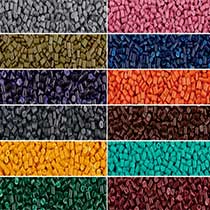
Products
TPEE3362 used for Opitical Fiber
Type and application
| Type | Product | Application and advantages |
| TPEE3362 | Thermoplastic Polyester Elastomer TPEE | Secondary Coating Materials Used for Optical Fiber |
Product description
Thermoplastic polyester elastomer (TPEE) is a kind of block copolymer, It includes crystalline polyester hard segment which has properties of high melting point and high hardness and amorphous polyether or polyester soft segment which has properties of low glass transition temperature, It is formed into two phase structure, the hard segment crystallization have an effect on physical cross linking and stabilize product dimension, soft segment have an effect on amorphous polymer with high resilience.Therefore, To increase the proportion of hard section can improve the hardness, strength, heat resistance and oil resistance of TPEE. To increase the ratio of soft segments can improve the elasticity and low temperature deflection of TPEE.TPEE also has the properties of softness and elasticity of rubber, as well as the rigidity of thermoplastic and easy processing. Its shore’s hardness is 63D .
Processing technology
The recommended processing temperature
| Zone | Extruder body 1 | Extruder body 2 | Extruder body 3 | Extruder body 4 | Extruder body 5 | Flange | Extruder head | Hot water | Warm water |
| /℃ | 225 | 230 | 235 | 240 | 240 | 235 | 235 | 25 | 20 |
Storage and transport
Package:
Two package ways:
1. It is packed 900/1000KG per bag with the inner lining of aluminum foil material, outer lining of PE woven material.
2. It is packed 25KG per bag with inner lining of aluminum foil material , outer lining of kraft paper material.
Transportation: The product should not be exposed to get wet or humidity during transportation, and keep it dry, clean, complete and pollution-free.
Storage: The product is stored in a clean, cool, dry and ventilated warehouse away from the source of fire. If the product is found to be damped in rainy reason or with high moisture in the air, It can be used three hour later after it is dried at the temperature of 80-110℃ .
Properties
| Inspected properties | Test Method | Unit | Value | |
| Rheological property | Melting Point | ISO 11357 | ℃ | 218.0±2.0 |
| (250℃、2160g)The melt flow rate | ISO 1133 | g/10min | 22 | |
| Intrinsic viscosity | - | dL/g | 1.250±0.025 | |
| Mechanical properties | Hardness after (3S) | ISO 868 | Shore D | 63±2 |
| Tensile Strength | ISO 527-1 | MPa | 41 | |
| Bending Strength | - | MPa | 13 | |
| Initial Tear Resistance | ISO 34 | KN`m-1 | N | |
| Elongation at break | ISO 527-1 | % | >500 | |
| Break type | - | - | P | |
| Flexural Modulus | ISO 178 | MPa | 450 | |
| Other | Specific Gravity | ISO 1183 | g/cm3 | 1.26 |
| Water Absorption | GB/T14190 | % | 0.06 | |
| Processing temperature | Drying tem. | - | ℃ | 110 |
| Drying time | - | h | 3 | |
| Extruding tem. | - | ℃ | 230-240 | |
| The data provided are the typical ranges of product properties. They should not be used to establish specification limits or used alone as the basis of design | ||||
| Appearance | Supplied in cylindrical pellets free from contamination, fines and other defects. | |||





